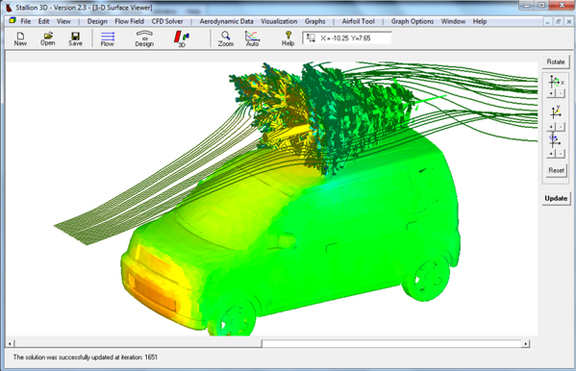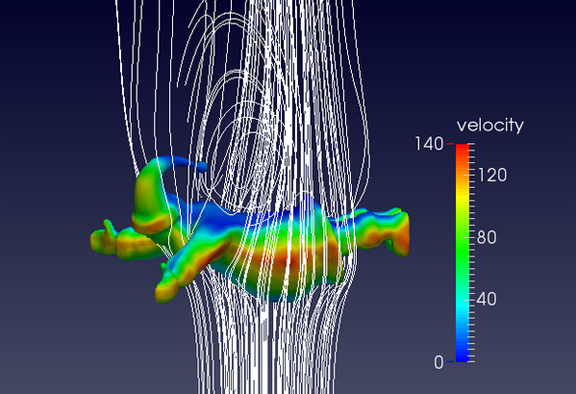Latest News
December 23, 2013
How do engineers entertain themselves between eggnog and dinner? How do they amuse themselves when the stockings are stuffed, the trees are trimmed, and the angels on the windowsills are strung? Well, apparently, some fire up their favorite simulation programs to run imaginative CFD tests to examine well-known X’mas phenomenons, ranging from the practical to the miraculous.
After picking up a Christmas tree for his home, Patrick Hanley, Ph.D., who runs Hanley Innovations, decided to reproduce the airflow around his minivan with the giant pine shrub strapped to the top. He downloaded from TurboSquid the 3D model of a car that was “close enough” to his own, downloaded and scaled a Christmas the same way, and imported the assembly into Stallion 3D, the aerodynamic analysis package he developed. Patrick applied Navier-Stokes equations to the setup to calculate the airflow.
“I wanted to make sure the pressure build up and the flow lines look correct in the results ... I started the simulation run before midnight. By one o’clock, it was done,” he said.
He ran the job on a four-core laptop (but delegated only two to the job), using a low-res mesh. For upfront simulation (his specialty), that’s sufficiently accurate. But if he had more computing resources at his disposal (say, a university research lab’s supercomputer), Patrick said he’d run the same job in high-res—“to get every single leaf and capture every feature of the car in the boundary conditions,” he said.
Giles Richardson, who distributes a combined mesh-and-solve CFD freeware from his site UFO-CFD, decided to show off what his software can do by simulating Santa’s freefall or skydive (an unfortunately scenario that might occur if his sleigh accidentally takes a tumble in a wide turn to avoid an obstructing chimney). He obtained a SketchUp model of Santa, converted it to STL, and performed a falling simulation using immersed boundary method.
Richardson said, “The simulation was done just for some X’mas fun, but typical things of interest would be the surface pressure distribution (for lift/drag analysis) and any separation/recirculation regions. The assumed air speed is 100m/sec and a laminar flow solution has been assumed (turbulence not yet included in the solver).”
The one-million cell simulation with uniform Cartesian mesh resulted in velocity contours depicting the falling Santa’s lifts and drags. The flow patterns around St. Nick’s rotund belly suggests he should be more judicious with the cookies he’s been consuming at every delivery destination.
Richard Smith, owner of Symscape, presents the more quirky side of simulation twice a year: on April Fool’s and in Christmas. This week, he’s trespassing on the territories of Star Trek and The General Theory of Relativity. Richard wrote in his blog:
For Santa to meet his aggressive toy delivery schedule on X’mas eve, it would appear that he has to travel impossibly fast. Yet there are often sightings of Santa on his rounds, which seems to contradict this high speed hypothesis. The only way to explain Santa’s whereabouts is that he uses a Reality Distortion Field (RDF).
Richard proposed St. Nick and his cloud-galloping reindeer “traverse space within a bubble” at “10 m/s, directly compatible with the speed reindeer can comfortably maintain.” Santa’s omnipresence is possible because “RDF ... distorts the observer’s reality.”
Using a SketchUp Santa-on-sleigh model in 3D, Richard set about proving his Santa-in-bubble theory in Caedium Professional. He used incompressible, steady-state RANS solver, with the k-omega SST turbulence model. On six CPU cores, the job ran about 10 minutes. Assuming Santa doesn’t hold a grudge against him, Richard would like to have “more powerful hardware” for Christmas from St. Nick.
The examples cited above are part of a Holiday-themed Simulation Friday (#SimulationFriday) challenge on Twitter, started by e-FEM‘s cofounder and CEO Matteo Vettori.
#SimulationSCC is… #SimulationFriday #SantaClaus #Contest | Share your #Christmas Simulations | starts Dec-20 ends Dec-24 @ 12PM— Matteo Vettori (@matteovettori) December 19, 2013
Are you using CFD to dissect a Christmas miracle? If so, please share your exercise in the comments. I’m sure it’ll be food for thought, to ponder under a mistletoe or to chase down with some strong punch.
Note: This blog post was originally published on Dec 23, 2013; it was later updated with additional details about UFO-CFD’s simulation and #SimulationFriday challenge on Twitter.
Patrick recorded his experiment in this YouTube clip below:
Subscribe to our FREE magazine, FREE email newsletters or both!
Latest News
About the Author
Kenneth Wong is Digital Engineering’s resident blogger and senior editor. Email him at [email protected] or share your thoughts on this article at digitaleng.news/facebook.
Follow DE








